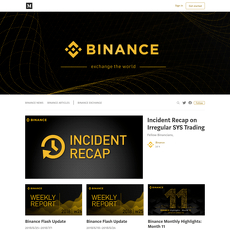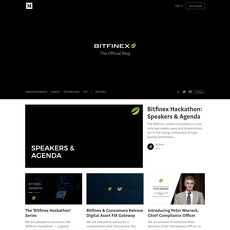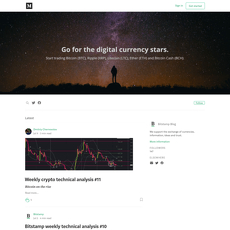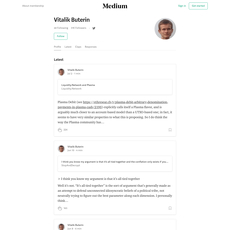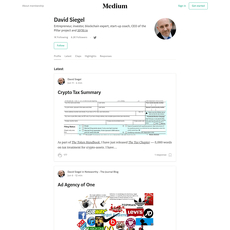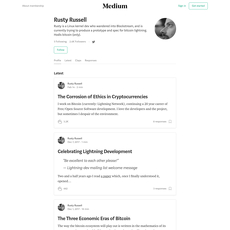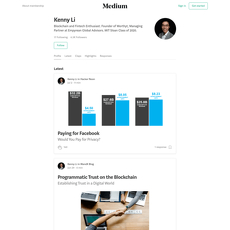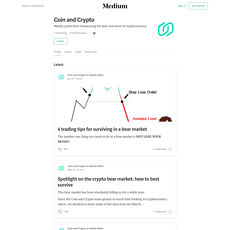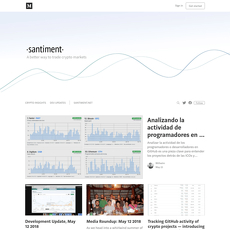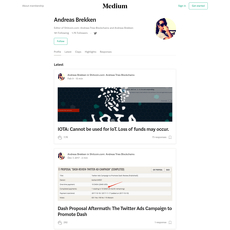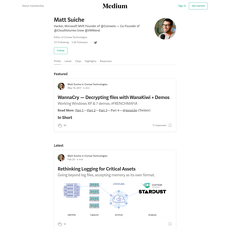Chris Burniske Review
Chris Burniske
medium.com
Chris Burniske Medium Review Guide: Everything You Need to Know (with FAQ)
Ever scroll through crypto Twitter, get hyped by ten “must-read” threads, and end the day with zero clarity? If you care about understanding crypto cycles, valuation frameworks, and where this industry is headed, you’ll want sharper ideas—not louder opinions. That’s why people keep pointing to Chris Burniske’s Medium.
This review keeps things practical. I’ll show you what to read, how to use his ideas, and where the real value is—so you can think clearer and act smarter.
It’s hard to filter noise in crypto
Here’s the honest problem: crypto is a loud room. Everyone has takes; few have frameworks. And while hot takes trend, they rarely help you make better decisions next quarter, let alone next cycle.
- Firehose without a filter: Hundreds of charts, zero structure. You end up reacting, not reasoning.
- Predictions without base rates: Without historical context, you’re guessing. Studies on attention and momentum (for example, NBER research on crypto returns) show sentiment moves markets—great for headlines, risky for portfolios.
- Jargon that doesn’t map to action: “Adoption,” “moats,” “network effects”—but what do you actually track or change on Monday?
- Narrative whiplash: One week it’s “BTC only,” the next it’s “ETH real yield,” then it’s “restaking or bust.” Without a framework, your thesis swings with the timeline.
You don’t need more opinions—you need a way to separate what lasts from what trends.
That’s where a good Medium feed can help—if it’s built on clear mental models. Chris’s writing tends to avoid hype and instead gives you spine-of-the-ship thinking: cycles, valuation logic, ETH/BTC roles, and network effects you can actually reason about. Think Metcalfe’s Law for networks, reflexivity for narratives, and simple sanity checks you can reuse. It’s not about being right once—it’s about thinking better every time.
I’ll make this simple
Here’s what you can expect from this Chris Burniske Medium review:
- Themes that matter: I’ll break down his most useful ideas—cycles, valuation frameworks, ETH and BTC narratives, and network effects.
- Where to start: A focused reading path so you’re not overwhelmed. Quality over quantity.
- Who benefits most: Investors, analysts, founders, and curious learners who want structure, not noise.
- How to apply it: Turn takeaways into checklists, metrics, and sanity checks you can use in research and portfolio reviews.
What this review covers
- Who Chris is and why his Medium matters in a market full of short-term takes
- The best topics he writes about: valuation, cycles, ETH/BTC thinking, network effects
- Pros and cons you should know before you invest time
- How to read efficiently and avoid “content paralysis”
- A quick FAQ with straight answers (no fluff)
If you’ve been looking for a way to cut through the noise and build a durable research process, you’re in the right place. Ready to see why his Medium is worth a spot in your weekly routine—and what to expect before you open the first post?
Who is Chris Burniske and why his Medium matters
Quick background
Chris Burniske sits at the intersection of research and real skin-in-the-game. He’s a partner at Placeholder VC, co-author of the 2017 book “Cryptoassets”, and previously led crypto research at ARK Invest when most of the industry was still asking whether Bitcoin would go away.
His work took off because he didn’t just cheerlead tech—he gave people language and structure to think with. The book introduced everyday readers and professionals to valuation ideas like the quantity theory of money applied to tokens (MV=PQ) and the difference between protocol tokens and application tokens. Years later, those same questions still show up in boardrooms and research memos.
“ETH is a triple-point asset.”
That single line—now a common mental model—captures how he frames Ether as part money, part productive capital, part commodity-like fuel. Love it or hate it, it forces clarity about what you believe ETH actually is.
- Investing cred: Early frameworks used by allocators to size positions and set risk bands.
- Research DNA: Bridges classic ideas (like reflexivity and network effects) with onchain realities.
- Builder relevance: Helps founders map token design to real demand and retention loops, not wishful thinking.
There’s a reason his posts get passed around during stress and euphoria. When volatility amplifies fear or FOMO, a clean model is calming. You don’t need a prediction; you need a process.
What you’ll find on his Medium
Head to Chris’s Medium and you’ll get essays that connect market structure, user behavior, and incentives. It’s not ticker talk; it’s how systems evolve and why prices reflect that over time.
- Cycle essays that actually age well: He maps how liquidity, narratives, and adoption reinforce each other—useful whether you lived 2018’s crypto winter or discovered crypto during DeFi summer. Industry and academic work on reflexivity and investor behavior back this up: narratives move flows, flows move price, price reshapes narratives.
- Valuation building blocks: From usage and fees to velocity and monetary premium, he shows which dials matter for different assets. If you’ve ever asked “Why does this token accrue value?” you’ll find the right questions to test.
- ETH/BTC mental models: Expect comparisons that cut through tribal noise—ETH as productive money, BTC as pristine collateral and store of value. Not a zero-sum take; a portfolio view.
- Networks and moats: Distribution, dev ecosystems, and switching costs—how these shape durable edges. It’s the kind of lens founders use when deciding where to build, and investors use when deciding what to hold through drawdowns.
When the room is loud, his posts read like a well-lit map. One reader told me, “I stopped chasing headlines and started tracking the right metrics.” That’s the shift you want: from reactive to prepared.
How I review
I’m ruthless about signal, shelf-life, and usefulness. If an idea can’t survive a cycle, it’s noise. Here’s the filter I use when I read his essays:
- Evergreen first: Concepts that still make sense across 2017, 2020, 2022 and today. For example, the reflexivity lens consistently explains how narrative, liquidity, and adoption interact—supported by long-standing market research on feedback loops.
- Clear assumptions: Good frameworks state what would prove them wrong. I flag posts that spell out the metrics to watch (usage, fees, issuance, liquidity conditions) versus takes that can’t be tested.
- Action translation: I look for prompts you can turn into a simple checklist: What must be true for this thesis? Which onchain/market data tells you it’s happening? What would change your mind?
- Emotional usefulness: Does it help during stress? The best pieces lower anxiety by narrowing focus to a few drivers you can actually monitor.
When a framework lines up with what we know about network growth (think Metcalfe-like effects) and incentive design—and you can track it in real time—that’s keeper material.
You’ve got the “why” and the “what” behind his writing. Next up: which recurring themes will actually sharpen your decisions in the next cycle, and how to use them without getting lost. Which one do you think will move the needle most for you—cycles, valuation, or ETH/BTC roles?
Core themes Chris returns to (and why they’re useful)
Crypto cycles and reflexivity
I come back to this thread of Chris’s thinking again and again: narratives don’t just reflect price—they help create it. Liquidity, attention, and adoption reinforce each other, for better or worse. That’s reflexivity in practice.
Real-world snapshots you’ll recognize:
- 2017 ICO heat → ETH demand → higher prices → more ICOs. Narrative pulled liquidity in, which funded experiments, which raised attention, and the loop intensified—until it didn’t.
- 2020 DeFi Summer → usage spiked → fees rose → tokens looked “productive.” Utility fed valuation stories; the story brought fresh capital that boosted utility further.
- 2021 NFTs → creators onboarded en masse → new users → infra demand. Culture became top-of-funnel distribution for blockspace, wallets, and L2s.
There’s research to back the feedback loop idea. Social activity and price co-move in crypto; in one widely cited study, researchers found that attention spikes tend to correlate with market run-ups and drawdowns (Garcia et al., Scientific Reports). Or consider onchain reflexivity: higher fees can signal real usage, which can attract more builders, which can lead to better apps… and another leg in the cycle.
Where Chris adds value is giving you language to label these loops, so you don’t confuse heat for signal. When you can say, “This looks like narrative-led liquidity, not fundamentals catching up,” you trade less from fear and more from plan.
“Narratives pull forward demand; usage sustains it.”
That line sits at the top of my notes whenever a new hype wave starts to build.
Valuation frameworks
Most crypto commentary stops at “number go up.” Chris pushes the harder question: what actually drives value here? He blends old and new—cash flow thinking, network effects, and monetary premiums.
- Usage → revenue → value capture. If a protocol throws off fees (or burns fees), there’s at least a path to valuation. EIP-1559’s fee burn turned Ethereum blockspace into a quasi buyback; during high activity, net ETH issuance has even gone negative. That’s a real mechanism you can track.
- Velocity and sinks. Assets with strong uses (collateral, gas, staking) and strong sinks (lockups, burns) can support a monetary premium. Assets built on pure emissions without demand sinks struggle once incentives fade.
- NVT, take rates, and unit economics. Nothing is perfect, but a blend of onchain activity (transactions, fees, active addresses) and protocol “take” gives you a sanity check. It won’t time tops, but it keeps you from fairy tales.
When I read his pieces on valuation, I extract checklists: where does the cash/utility flow, who pays, what forces them to keep paying, what makes it hard to switch? It sounds simple—until you try to apply it across L1s, L2s, and apps and realize most tokens don’t pass the test.
ETH, BTC, and the “triple‑point” asset idea
One of the most useful mental models he popularized is thinking of ETH as a triple‑point asset—part money (store-of-value), part capital asset (staking rewards/fee flow), part commodity (consumed as gas). BTC, by contrast, is framed as pristine collateral and digital SOV with unrivaled credibly-fixed supply.
- ETH as productive collateral: staked ETH earns from priority fees and MEV while securing the network. That gives it a cash-flow-like dimension traditional investors can parse, even if those flows are probabilistic and tied to activity.
- BTC as base collateral: its strength is simplicity and predictability. In both CeFi and DeFi, BTC is the “cleanest” asset to borrow against, and it often anchors macro narratives (liquidity, rate cycles, ETF flows).
Whether you agree or not, the framework forces clarity. If you think ETH isn’t a capital asset, explain why fee dynamics, burn, and staking don’t qualify. If you think BTC is more than SOV, explain the path to utility that preserves purity. You end up with sharper theses, less tribalism.
Networks, moats, and market structure
Open networks don’t build moats the way Web2 did. Chris zeros in on where moats do emerge:
- Developer gravity: ecosystems with deep tooling, docs, and grants pull talent. The annual Electric Capital Developer Report keeps showing Ethereum’s lead in active devs; that compounding matters.
- Liquidity begets liquidity: AMMs like Uniswap carve moats from network liquidity, integrations, and brand. Once the order flow is there, routing and MEV ecosystems reinforce it.
- Standards and distribution: stablecoin rails, wallet defaults, and L2/rollup distribution shape outcomes. Being the default in wallets or exchanges can outweigh a 10% tech edge.
- Security and Lindy: time without catastrophic failure builds trust. That trust lowers the cost of capital for builders and users, making the next win easier.
Market structure weaves through all this. ETF inflows and basis trades change BTC’s plumbing. L2 fee markets change ETH’s economics. Perp funding rates and stablecoin supply hint at risk appetite. The point Chris hammers home: understand the rails, not just the tickers.
If these themes clicked, here’s the fun part: how do you read his Medium without getting overwhelmed and actually put this to work in your portfolio or research flow? Want a 30-minute game plan that gets you the signal without the burnout?
How to read Chris Burniske’s Medium without getting overwhelmed
Start with the “spines”
When a thinker has a big catalog, I build a reading spine—3 to 4 cornerstone essays that everything else hangs on. It keeps me focused and stops the tab avalanche. Here’s how I line it up:
- Cycles and reflexivity: Look for his big-picture take on how liquidity, narratives, and adoption reinforce each other. Your goal: extract a simple cycle map you can reference later (e.g., thaw → spring → summer → euphoria → winter and what tends to change between phases).
- Valuation frameworks: Find his pieces that ask “what actually drives value?” Your goal: list the economic drivers (usage, fees, issuance, demand sinks, distribution) and connect them to measurable metrics.
- ETH vs BTC mental models: Read one strong essay on ETH’s roles (monetary, capital, utility) and one on BTC as pristine collateral/SOV. Your goal: summarize each asset’s job-to-be-done and how that shows up in data.
- Networks and moats: Grab a post that explores developer ecosystems and distribution. Your goal: define what “durability” looks like for a network—developer retention, fee sustainability, and user compounding.
That’s it. Four spines. Everything else becomes supporting detail you can read later without losing the plot.
Create a one-page summary per post
Reading is easy; explaining is hard. I keep a single page per essay—if I can’t make it fit on one page, I didn’t really get it. Education research backs this: self-explanation improves retention and transfer of knowledge across domains (see the literature summarized by Chi et al.). Spaced repetition also works—spacing your reviews out boosts memory, supported by a large meta-analysis (Cepeda et al., PNAS).
“If you can’t explain it simply, you don’t understand it well enough.”
Here’s the template I use:
- One-sentence thesis: The core claim in plain English.
- 3–5 supporting points: The best arguments, not every argument.
- So what: One line on how this changes my research or portfolio process.
- Metrics I can track: The data that would confirm or challenge the thesis.
- Counterpoints: The most credible pushback (forces me to avoid echo chambers).
- Open questions: What I still don’t know—and where to look next.
Example: If he argues that liquidity amplifies adoption via narrative flywheels, my “so what” might be: Build a dashboard with funding rates, stablecoin net issuance, fees, and active users to judge whether adoption is catching up to price or just following liquidity.
Turn ideas into actions
I translate each essay into a checklist with real data. Thoughts become habits only when they attach to a metric or a calendar. Some of what I track:
- Cycles and reflexivity
- Positioning & liquidity: Funding rates, open interest, stablecoin net issuance, exchange reserves (Glassnode/Santiment).
- Real activity: Fees, active addresses, transactions per user, L2 share of activity (Token Terminal, Dune, DefiLlama).
- Narrative heat: Trend score via Google Trends, developer report seasonality (the Electric Capital Developer Report is gold for dev momentum).
- Valuation frameworks
- Revenue quality: Protocol fees, take rate stability, fee/MCAP ratio (Token Terminal, Artemis).
- Supply dynamics: Emissions vs burn/buybacks, lock-ups/unlocks, treasury runway (project docs, Ultrasound.money for ETH).
- User economics: Cohort retention, CAC proxies (incentive spend vs retained users), share of non-incentivized activity.
- ETH mental models
- Security budget: Issuance minus burn, fee trends, MEV capture distribution.
- Staking health: Staked % of supply, net staking flows, validator churn (Rated, Beaconchain).
- L2 leverage on ETH: Share of transactions on L2s, L2 fee revenue, bridging flows.
- BTC mental models
- Onchain cycles: Realized cap, MVRV, HODL waves, SOPR, percent supply in profit (Glassnode).
- Security and fees: Hashrate trend, fees/issuance ratio—are fees gradually replacing block subsidy?
- Macro overlap: Real yields, dollar liquidity proxies, risk-on/risk-off correlations.
Simple alert ideas I use:
- Cycle sanity: If funding turns positive and climbs while fees and active users stall, tag it as “liquidity-led” and reduce conviction in sustained trend without adoption confirmation.
- ETH flywheel: If 30D fee MA rises, net staking inflows improve, and L2 share grows, tag as “strengthening fundamentals” and re-check valuation multiples next review.
- BTC regime shifts: If fees/issuance ratio makes new highs and long-term holder supply distribution starts to loosen, tag “late-spring/early-summer” behavior and widen outcome ranges.
Tools that keep me honest: Token Terminal, Glassnode, Messari, Ultrasound.money, Dune, Rated, and the Electric Capital Developer Report.
Keep your time in check
Attention is a position. I cap each reading block to stay sharp and stop turning a great essay into a 3-hour rabbit hole.
- 30–45 minute session plan
- 5 min: Skim headline, subheads, and any charts. Write your best guess of the thesis before reading.
- 15–20 min: Focused read. No extra tabs. If a reference is interesting, open it in a background tab and ignore it for now.
- 10 min: Fill your one-page summary. Force the “so what.”
- 5–10 min: Add 1–3 metrics to your dashboard or set alerts. If nothing is actionable, archive and move on.
- Pomodoro beats doomscrolling: I use 25/5 or 40/10 blocks. Short sprints reduce fatigue and improve recall. It’s not magic—it’s just how our brains work.
- Space your re-reads: Revisit your one-pagers weekly at first, then monthly. The spacing effect (robustly replicated) turns reading into durable understanding.
- Triage everything: I tag new essays as Now, Later, or Never. “Later” gets slotted on my calendar; “Never” is guilt-free delete.
When I feel the “open 12 tabs” itch, I remind myself:
Slow is smooth. Smooth is fast.
You’ve got the system. Want to know which flagship ideas are worth obsessing over next—cycles, valuation clarity, ETH’s real yield angle, and where BTC actually fits? Let’s unpack those together.
Flagship ideas you’ll probably care about
Cycle sanity checks
I like how he keeps you grounded when the market wants to make you either euphoric or terrified. Instead of all-or-nothing calls, he nudges you to set ranges and probabilities. That shift alone saved me from FOMO at highs and paralysis at lows.
“Frameworks beat forecasts.”
Here’s how I put his cycle thinking to work with real data:
- Use historical bands, not single targets. I track BTC and ETH against their realized price and MVRV bands to spot overheated or underloved zones. When BTC’s MVRV presses >3, I get cautious; when it sinks toward ~1, I get curious. You can monitor this via onchain analytics like Glassnode or Coin Metrics.
- Watch liquidity impulses. Risk assets (including crypto) have tended to respond to changes in financial conditions. When real yields rise sharply, risk premia expand and cyclicals wobble—crypto included. Check the US 10Y TIPS yield and a simple financial conditions index to sanity-check market tone.
- Separate usage from price. During 2022’s drawdown, active addresses and stablecoin settlement held up better than prices suggested. That mismatch often marks late-bear exhaustion rather than fresh trend strength. Coin Metrics’ State of the Network is good for this.
None of this is a crystal ball, but it helps you step back and say, “Given where we are, what’s a reasonable range?” That’s how you protect your capital and your sleep.
Valuation clarity
He pushes you past “number go up” into “why should value accrue here?” That question filters out a lot of shiny yet empty tokens.
What I look for, taking a page from his playbook:
- Fee capture and value sinks. Do users actually pay? Do those fees flow to token holders or strengthen the asset’s monetary premium? For Ethereum, the EIP‑1559 burn turned usage into a structural value sink by burning a portion of fees.
- Demand loops, not one-offs. Cold start incentives fade. Durable assets create loops: usage → fees → security/utility → better apps → more usage. If I can’t map the loop in one sentence, I get skeptical.
- Velocity and orthogonality. Tokens that must be spent and quickly replaced tend to leak value; tokens that anchor access, collateral, or governance can hold it. This “velocity problem” has been discussed since early cryptoasset research and still explains many chart graveyards.
To check my notes, I lean on data like protocol revenue (Token Terminal), fee trends (CryptoFees), and long-term holder supply (Glassnode). When fees rise while issuance or sell pressure falls, I pay attention.
ETH and real yield narratives
This is where his thinking gets practical for anyone who wants to understand “productive crypto.” ETH isn’t just a token that floats with risk—it can be staked to secure the network and earn native rewards. The key is understanding what’s real versus what’s just inflation.
- What feeds ETH staking rewards? A mix of issuance, priority fees, and MEV. Post-merge, issuance dropped dramatically; fees and MEV are usage-driven, not purely inflationary. See Ethereum’s own docs and MEV data via MEV-Boost.
- Security budget lens. As fees contribute more to security (and some are burned), ETH can straddle roles: monetary asset, capital asset (yield via staking), and utility asset (gas). I like how this framing forces you to ask: is the network paying for real security with real demand?
- Net, not gross. Real yield is what’s left after accounting for dilution, validator costs, and risk. Track net issuance at ultrasound.money and compare it with staking APR from multiple providers—not just the headline number.
A quick example of how this helped me: when staking queues were long after Shanghai, I stopped anchoring on a static APR and began watching fee spikes during onchain activity. That explained why rate prints moved—and whether they were sustainable or just short bursts.
BTC’s role and cross-asset thinking
He frames BTC as pristine collateral and macro-sensitive money, which keeps me honest when everyone tries to force it into a tech stock box or a DeFi token box.
- Macro pulse matters. BTC’s correlation with US equities has shifted through time, often rising during global liquidity shocks and falling as crypto narratives reassert. You can sanity-check this with rolling correlations versus the Nasdaq or S&P using public data or dashboards from major exchanges’ research portals.
- Collateral and reserve behavior. BTC’s fixed supply and deep liquidity make it a clean balance-sheet asset for allocators who want non-sovereign exposure. That narrative strengthens when real yields stabilize or fall and weakens when policy tightens aggressively.
- Compare without tribal bias. I track the ETH/BTC ratio not as “which tribe wins” but as a thermometer: risk-on within crypto tends to favor ETH and higher-beta assets; stress regimes or macro shocks often rotate back to BTC. That simple toggle has kept me from overfitting fancy models.
If you want to go deeper, line up three charts side by side: BTC vs. real yields (TIPS), ETH/BTC, and total crypto fees. When real yields cool while fees trend up, the cross-asset picture starts making sense across both BTC and ETH.
I’ll stop here before I get carried away. Want to know what I actually like about his approach, where people trip up, and how to squeeze the best signal out of it without wasting your time? That’s exactly where we’re headed next—curious what makes the cut and what doesn’t?
Pros, cons, and how to get the best signal
What I like
I go back to these essays because they help me think straighter when the market tries to yank my emotions around. The value shows up in three ways:
- Frameworks that age well: His reflexivity and cycle notes gave me sanity checks in 2021 euphoria and 2022 despair. When ETH’s post-Merge dynamics kicked in (issuance down, fees burned, staking yields visible on-chain), the earlier “productive + monetary” framing suddenly felt practical, not theoretical. You can see the mechanics yourself on tools like ultrasound.money.
- Clear reasoning without hype: He tends to put ideas on a spectrum, not in absolutes. That reduces the urge to chase the loudest narrative and pushes you to hold multiple scenarios at once.
- Useful mental models for builders and allocators: Network effects, distribution, moats, and capital formation are explained in a way that founders and investors can both use. I’ve used those same lenses to pressure-test token models and to avoid buying “utility” with no real demand loops.
“Frameworks beat forecasts.”
When I’m tempted to FOMO, that line brings me back to process over prediction. It’s not about guessing next week’s candle; it’s about asking better questions.
What to watch out for
- It’s not a trade alert feed: If you want entries/exits, you’ll be disappointed. These are strategy lenses, not signals.
- Assumes some base knowledge: A few posts jump straight into concepts like security budgets, fee burn dynamics, or reflexivity. If you’re early in your journey, skim once, learn the basics, then re-read. It’ll click.
- Ideas can be used as confirmation bias fuel: Strong frameworks feel great—but don’t twist them to bless your existing bags. I’ve learned to write down what would invalidate my take before I read on.
- Timing gap: High-level essays won’t save you from a 20% intraday move. Use them to set guardrails—not to micromanage trades.
Why this matters: research consistently shows that overtrading hurts returns. In one well-known study, Barber & Odean (2000) found the most active traders underperformed due to costs and poor timing. Process > impulse is a real edge.
How to get max value
Turning ideas into signal is where most people slip. Here’s what’s worked for me:
- Pair each theme with a live dashboard:
- Cycles and reflexivity → liquidity and funding metrics (open interest, funding rates, ETF flows), realized cap/realized profits. Tools: Glassnode, DeFiLlama.
- Valuation → fees, usage, supply changes, and take rates. Tools: Token Terminal, Dune.
- ETH/BTC narratives → ETH burn vs issuance and staking share; BTC liquidity and collateral usage. Tools: ultrasound.money, CoinGlass.
- Set “if-this-then-that” rules:
- If ETH’s burn consistently trails issuance for 180 days and L2 throughput stagnates, then I down-weight the “productive + monetary” momentum in my thesis.
- If BTC basis and spot flows decouple from macro risk-off days, then I upgrade its “collateral + SoV” resilience score.
- Summarize in one page: Thesis, 3 supporting points, 2 key risks, 1 invalidation. If you can’t explain it simply, you can’t execute it. Checklists work—there’s a reason Atul Gawande’s checklist approach cut error rates in high-stakes fields.
- Schedule a recurrent “cycle check”: Once a quarter, answer:
- What narrative is the market paying for right now?
- Where is liquidity expanding or contracting?
- What would make me wrong, and would I notice it fast?
- Tag emotions, not just data: Note when you feel FOMO or dread while reading. It sounds soft, but catching that surge early keeps you from forcing trades your thesis doesn’t support.
One last tip: keep a tiny “belief tracker.” For each big idea you borrow, write a date, the hypothesis, and the kill-switch. It’s amazing how much better decisions get when you make your assumptions visible.
Want to see exactly how different readers—investors, founders, and curious learners—can put this to work in under 10 minutes, with templates you can copy? That’s coming up next.
Who should read this—and how to apply it fast
If you’ve ever watched a green candle erase weeks of doubt—or a red one erase months of conviction—you know why clear thinking matters. Chris’s writing gives you rails. Use them to act, not just nod along.
“Clarity beats certainty. Frameworks guard your emotions when prices try to run the show.”
Investors and analysts
You’ll get the most by turning his models into fast, repeatable workflows that reduce guesswork and overconfidence.
- Build thesis one-pagers (10 minutes per asset): Why now, core drivers (fees, usage, liquidity), kill-switch conditions, and 3–5 metrics you’ll actually track. Think: L2 fee share, active users, staking ratio, issuance vs burn, liquidity depth.
- Use scenario ranges, not targets: map base/bull/bear with probabilities and time-to-recovery. This cuts “false precision” and aligns with research on probabilistic forecasts from Tetlock’s Superforecasting.
- Right-size with risk budget: size positions by risk, not vibes. A conservative half-Kelly approach is a solid sanity check when conviction is high but variance is wild.
- Narrative reality check: does usage back the story? Cross-check with onchain fees, user growth, and developer activity. The Electric Capital Developer Report shows ecosystems with stronger developer retention tend to sustain momentum longer.
- Liquidity matters: confirm that the asset can absorb size. Weekly depth data from Kaiko Research helps you avoid getting trapped in illiquid pumps.
Micro-example: For ETH, set base/bull/bear anchored to staking ratio, L2 throughput, and security budget. When fees compress and burn slows, treat that as a flag to re-weight probabilities rather than panic—this keeps you aligned with the “probabilities over predictions” ethos.
Quick sprint: Pick one asset you own. Write the one-pager, set scenario probabilities, and tie each scenario to two metrics you’ll track weekly. You’ll feel the emotional pressure drop almost immediately.
Founders and product folks
If you’re building, his work is a shortcut to clearer positioning and cleaner token mechanics.
- Map the value loop: who pays, who earns, and why the token must exist. If the token isn’t needed for the core transaction, consider keeping it out of the way until it is.
- Choose the job of the token: money, governance, or work. Mixing all three raises complexity and weakens trust. His “multi-role asset” thinking helps you avoid muddled incentives.
- Security budget math: can fees, not emissions, fund security or rewards over time? If not, emissions are debt. The a16z 2024 State of Crypto highlights how sustainable fee models correlate with durable networks.
- Design emissions with half-lives: make sure user value half-life is shorter than your incentive half-life. Gauntlet case studies show mercenary liquidity leaves when rewards end; pair rewards with sticky utility (discounts, priority access, in-protocol rights).
- Go where builders are: developer retention is a moat. Electric Capital’s data shows ecosystems with experienced devs (>2 years) compound faster than those reliant on new arrivals alone.
Micro-example: For a DEX launching on an L2, use a points program tied to useful actions (LP in volatile pairs with oracle-proofed ranges, routing improvements) and burn a portion of protocol fees to counter emissions. Track cohort retention and fee-to-emissions ratio weekly; cut rewards that don’t lift these.
Quick sprint: Sketch a one-slide “token jobs” diagram, list top two value sinks, and set one ruthless kill-switch metric (e.g., fee-to-emissions < 0.7 for 4 weeks).
Curious learners and researchers
If you like structured thinking and want to avoid echo chambers, this is your playground. Make it practical fast.
- Adopt a 30–30–30 routine: 30 minutes reading one essay, 30 making a concept map, 30 checking one metric on an open dashboard like Dune or Ultrasound Money.
- Ask better questions: Who pays? Where does value accrue? What breaks this? If usage vanished, would the token still matter?
- Keep a narrative ledger: Write one-sentence forecasts with a % probability and review monthly. Tetlock’s work shows this habit alone improves calibration.
- Bias guardrails: Name your bag before you read. It sounds silly, but it’s a quick way to catch confirmation bias before it catches you.
Micro-example: Read a post on ETH’s “triple-point” role. Then check L2 throughput, ETH burn rate, and staking ratio trend. If burn weakens while throughput rises, ask: is value accruing at the L2/app layer instead—and what would have to change for ETH to re-assert value capture?
Quick sprint: Build a 10-term glossary (reflexivity, network effects, security budget, distribution, real yield). Every time you read a new essay, tie it to one of those terms. You’ll remember more and argue less.
Wondering whether this approach helps with timing, if there are actual signals, and where you should start reading first? Keep going—I answer those next.
FAQ: quick answers to common questions
Is Chris Burniske reliable?
Short answer: yes, as long as you treat his work as frameworks, not fortune telling. He’s consistently early on mental models that end up shaping the conversation. A well-known example is his 2019 framing of ETH as a “triple-point asset” (monetary, capital, and utility)—well before staking and EIP-1559 turned ETH’s cash-flow and burn dynamics into mainstream talking points.
He’s also transparent about uncertainty. You’ll see him stress scenarios over certainties, which is rare and valuable in a market that rewards loud calls. Does he nail every thesis? Of course not. But the bar is “does this help me think more clearly when conditions change?” and he reliably hits that.
One data point I like: his early pieces on valuation using the quantity theory (MV=PQ) pushed the space to quantify velocity and utility assumptions. Academic and industry work since then has shown investor attention, liquidity, and usage often co-move with price in reflexive loops—exactly the kind of dynamic he urges readers to model (for example, multiple studies have found that search interest and social attention correlate with crypto returns during momentum phases). That doesn’t mean “always up,” it means “know the loop you’re in.”
Where should I start on his Medium?
If you want the most signal per minute:
- Cycles and reflexivity: Start with his essays that map how narratives, liquidity, and adoption feed each other. You’ll get language for describing where we are in a cycle without pretending to be precise.
- Valuation basics: Read his breakdowns on value accrual and velocity. Even if you disagree with parts, you’ll come away with a better checklist for what could capture value and what probably won’t.
- ETH vs. BTC mental models: His “triple-point” framing for ETH and his treatment of BTC as pristine collateral/SOV are great for clearing out tribal fog. You’ll learn to compare roles, not cheerlead.
Give yourself two focused sessions—30–45 minutes each—to read and jot a one-page summary for the first two. That small effort pays for itself when markets get loud.
Does he post trading signals?
No. Think strategy, not signals. But you can turn his ideas into your own signals. Here’s how I’ve done it:
- From narrative to checklist: If a post argues a network should accrue value when real usage grows, I track active addresses, fees/revenue, and fee-to-valuation ratios (e.g., market cap/annualized fees) across time. When the story and the math diverge, that’s a flag.
- From reflexivity to risk: If attention is surging (funding, OI, social/search), I tighten risk. If usage is improving while attention is flat, I get interested. That’s not an “entry,” that’s a nudge for deeper work.
Frameworks point the flashlight. Your system still pulls the trigger.
Will this help me time the market?
Indirectly, yes—because timing improves when your expectations are grounded. His cycle work helps you spot when narratives are stretching beyond fundamentals or when fundamentals are quietly compounding under the surface.
Concrete example: during the 2021 run, the combination of EIP-1559 burn + NFT demand + L2 ramp created a feedback loop where fees, attention, and ETH pricing power reinforced each other. A reflexivity lens would push you to ask, “What breaks this loop?” (e.g., macro liquidity contraction, fee migration to L2s without value capture) instead of simply extrapolating. That shift won’t give you a magic top tick, but it materially improves risk control.
There’s also empirical support for this approach: multiple peer-reviewed studies have found that crypto’s retail attention and liquidity conditions tend to amplify moves. Recognizing the loop you’re in and when inputs change can be the difference between riding a trend and round-tripping it.
How often should I revisit his posts?
Quarterly is a good baseline, with extra passes at major market inflection points. I also set “triggers” that prompt a reread:
- Macro/liquidity shifts: Central bank policy turns, dollar strength, or sharp changes in global liquidity.
- Network economics events: Upgrades that change fee flows, staking dynamics, or issuance schedules.
- Narrative regime changes: For example, when ETH/BTC trends flip or when a new sector (L2s, restaking, RWAs) becomes the market’s focal point.
Each reread tends to reveal a blind spot you didn’t notice the last time.
Can beginners follow along?
Yes—just pace yourself and set a tiny foundation first. If you’re newer, do this:
- Learn the core terms: staking, issuance, fees, token velocity, reflexivity, monetary premium. A 20-minute primer on each goes a long way.
- Translate as you read: For every essay, write a three-line “so what” in plain English: what would make this thesis stronger, what would falsify it, and what one metric should I track?
- Keep it real: Pair each idea with one chart (fees, active addresses, or ETH/BTC) so the concept doesn’t float in theory land.
Most readers overestimate how much they need to read and underestimate how much they need to summarize. The summaries are where understanding sticks.
Pro tip: If you can’t explain his thesis to a friend in 60 seconds without notes, you didn’t get it yet. That’s normal—go one level simpler.
Want a simple, copy-paste plan to turn these answers into your weekly research rhythm? I’ve got you covered next—how about a one-page template, five practical checks, and a 30-minute routine you can actually keep?
Final tips, next steps, and how I use this in my own research
My quick-start plan for you
If you want results fast, here’s the plan I’ve refined and actually use. It turns big ideas into a routine you can run week after week.
- Pick 3 cornerstone essays: one on cycles, one on valuation, one on ETH/BTC roles. Don’t overthink it. Commit to those three first.
- Create a one-page summary per essay with four boxes:
- Thesis: the single sentence you’d defend in a debate
- Leading indicators: 3–5 datapoints you’ll check weekly
- Failure conditions: what would make this thesis wrong
- Action hooks: what you’ll do if X or Y flips
- Extract 5 practical checks you’ll reuse in research or portfolio reviews. Here’s a starter pack I keep pinned:
- Usage and capacity: Check L2 throughput and gas pressure (source: L2Beat). Are blocks consistently full? Are L2s processing more txs than L1?
- Value capture: Track protocol revenue vs tokenholder capture (source: Token Terminal) and for ETH specifically, fee burn vs issuance (source: ultrasound.money). Is net supply expansion or contraction?
- Liquidity reflexivity: Monitor stablecoin netflows and perp market structure—funding, open interest as % of free float, and basis (sources: Coinalyze, Laevitas). Are flows and leverage amplifying the narrative?
- Builders and momentum: Glance at monthly active devs (source: Electric Capital Dev Report) and repo commits for key ecosystems. Is developer energy rising while price chops?
- Cross-asset sanity checks: Watch ETH/BTC relative trend (200D MA), the real yield gap (staking yield minus 10Y UST), and BTC ETF net flows (source: Farside). Is macro wind at your back or in your face?
Why so structured? Because checklists work. In complex fields, checklists have been shown to cut errors and improve outcomes (see Atul Gawande’s Checklist Manifesto). In markets, simple, repeatable rules beat “vibes.”
Keep sharpening your edge
I treat ideas like code: version them, test them, and retire what breaks. Here’s the rhythm that keeps me honest.
- Weekly cadence:
- Monday: Macro + liquidity. Funding, basis, DXY, rates, ETF flows.
- Wednesday: Onchain. Fees, active addresses, L2 activity, burn/issuance, TVL shifts (source: DeFiLlama).
- Friday: Narrative journal. What changed this week? One paragraph, no fluff.
- Monthly post-mortem: Pick two calls (good or bad). What was the thesis, what actually happened, what did I miss? Post-mortems and premortems improve decision quality (see Gary Klein’s HBR piece on premortems and Tetlock’s work on Superforecasting using Brier scores).
- Spaced re-reads: Revisit your one-pagers at 1 week, 1 month, 1 quarter. The forgetting curve is real (Ebbinghaus), and spaced repetition preserves signal.
- Scenario ranges, not single points: Write bull/base/bear with probabilities and triggers. Then track who “wins” each month. Forecasters who think in ranges outperform point guessers (Tetlock).
Example trigger I use: “If 30‑day ETH fees < issuance for 3 months and validator exits accelerate, shift ETH from Overweight to Neutral until net burn returns.”
One extra nudge: trade less, think more. Overtrading destroys returns. In a classic study, Barber and Odean (Journal of Finance, 2000) found active retail traders significantly underperformed due to overconfidence. A tight checklist guards you from your own FOMO.
A small reminder
Nothing here is financial advice. These are tools, not prophecies. Your time horizon, taxes, liquidity needs, and drawdown tolerance matter more than any framework. Keep your checklist short (10 items max), review it often, and be ruthless about what’s actually helping you make better calls.
What I’m doing next (steal this plan)
- Bookmark a reading slot: 30–45 minutes every Wednesday. No notifications, just one essay and a one-page note.
- Stand up a simple dashboard: L2Beat, Token Terminal, ultrasound.money, DeFiLlama, and an ETF flow tracker. Five tabs, one glance.
- Write two pre-commit rules:
- “I don’t change positions on weekend headlines.”
- “I only act when at least 3 checklist items flip.”
- Quarterly reset: Re-read your three cornerstone notes, archive one idea that failed, add one new essay to the stack.
Bottom line: use his essays to think cleaner, pair them with hard data, and let a simple process compound your edge. Bookmark your workflow, keep the cadence, and keep your notes tight. If this approach helps, stick around at cryptolinks.com/news—I’ll keep sharing the no-nonsense playbooks that actually move the needle.


